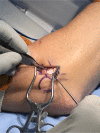Chronic lateral epicondylitis: challenges and solutions
- PMID: 30464656
- PMCID: PMC6214594
- DOI: 10.2147/OAJSM.S160974
Chronic lateral epicondylitis: challenges and solutions
Abstract
Lateral epicondylitis (LE) is a significant source of pain and dysfunction resulting from repetitive gripping or wrist extension, radial deviation, and/or forearm supination. Although most cases are self-limiting over several years, controversy exists regarding the best treatment strategy for chronic LE. Nonsteroidal anti-inflammatory drugs (NSAIDs), physical therapy (PT), shockwave therapy, and injections with corticosteroids or biologics are all conservative treatment options for LE. For refractory cases, surgical options include open, arthroscopic, and percutaneous techniques. In this review, the current evidence behind these treatment strategies is presented. The data demonstrate that NSAIDs, PT, bracing, and shockwave therapy provide limited benefit for treating LE. Biologics such as platelet-rich plasma and autologous whole-blood injections may be superior to steroid injections in the long-term management of LE. Although the initial results are promising, larger comparative studies on stem cell injections are needed. For refractory LE, open, arthroscopic, and percutaneous techniques are all highly effective, with no method seemingly superior over another. Arthroscopic and percutaneous approaches may result in faster recovery and earlier return to work.
Keywords: biologics; injection; lateral epicondylitis; platelet-rich plasma; shockwave; stem cells; surgery; tennis elbow.
Conflict of interest statement
Disclosure The authors report no conflicts of interest in this work.
Figures
References
-
- Allander E. Prevalence, Incidence, And Remission Rates of Some Common Rheumatic Diseases Or Syndromes. Scand J Rheumatol. 1974;3(3):145–153. - PubMed
-
- Verhaar JA, Elbow T. Anatomical, epidemiological and therapeutic aspects. Int Orthop. 1994;18(5):263–267. - PubMed
-
- Kurppa K, Viikari-Juntura E, Kuosma E, Huuskonen M, Kivi P. Incidence of tenosynovitis or peritendinitis and epicondylitis in a meat-processing factory. Scand J Work Environ Health. 1991;17(1):32–37. - PubMed


